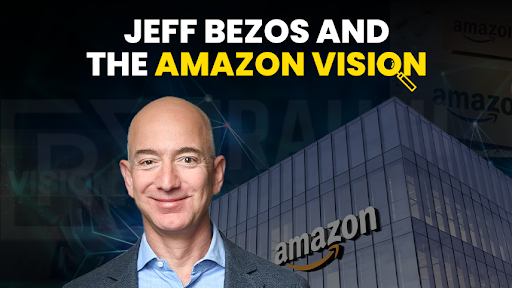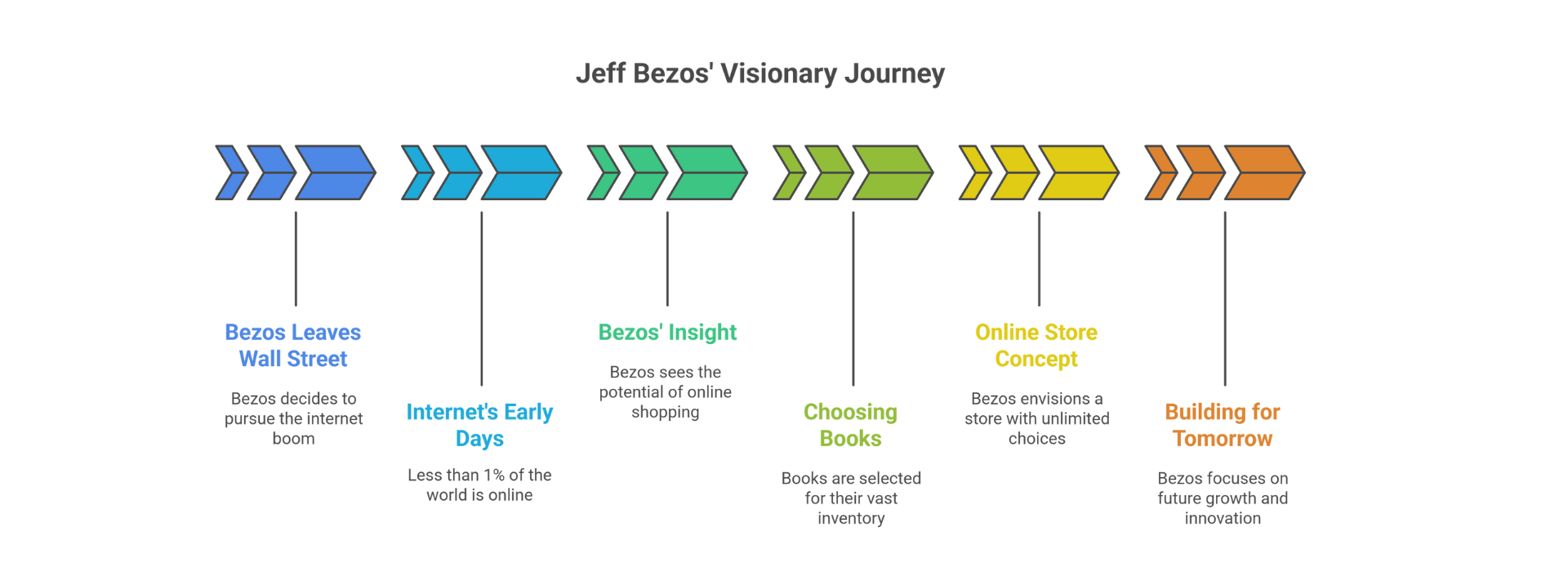
Jeff Bezos’ Amazon Vision: Leadership and Long-Term Thinking Case Study
When you hear the name Jeff Bezos, what comes to your mind first? For many, it’s the story of a man who started by selling books online and built Amazon, one of the most powerful companies in the world. But if you look deeper, his real legacy isn’t just Amazon. It’s his way of thinking. Bezos was never obsessed with quick profits or short-term gains. Instead, he built everything on the foundation of long-term vision.
For Indian entrepreneurs, business owners, and professionals, this story is not just inspiring; it’s a roadmap. In a country where small businesses often get trapped in daily struggles, Bezos’s style of thinking can open new doors. So, let’s dive into this case study of Jeff Bezos and discover how his long-term mindset shaped Amazon’s rise, and more importantly, what lessons Indian businesses can take from it.
The Early Days: A Simple Idea with a Big Dream
In 1994, Jeff Bezos left his job at a Wall Street investment firm and decided to chase the internet boom. At that time, less than 1% of the world’s population was online. At one time, many people wrote off the internet as just a passing trend. But Bezos saw something others didn’t; he realized the internet could change the way people shop.
He chose books as the starting point, not because he loved books more than anything else, but because books had thousands of titles that physical stores couldn’t keep in stock. The internet gave him the ability to offer customers more choices than any bookstore ever could.
Think about it: an Indian entrepreneur today might say, “Why should I open an online store when offline shops are everywhere?” That’s exactly how people in the US felt in 1994. But Bezos was already thinking ten steps ahead. He wasn’t looking at today; he was building for tomorrow.

The Obsession with Customers
If Amazon can be summed up in a single phrase, it would be “customer obsession.” Bezos firmly believed that focusing on the customer ensures everything else falls into place. He once said, “We don’t focus on competitors, we focus on customers.”
This thinking shaped every decision Amazon made. Fast delivery, easy returns, low prices, and constant innovation, none of these were not random. They were all results of putting the customer at the center.
Now, compare this to many Indian businesses. How often do we see companies focusing more on short-term profit than customer experience? A shopkeeper might charge a little extra today to make quick money, but in the long run, the customer may never return. Bezos showed that loyalty is built when the customer feels valued, not when the business squeezes them for money.
Thinking in Decades, Not Quarters
Most CEOs around the world are pressured by shareholders to show profits every three months. But Bezos ignored that pressure. He consistently reminded investors that Amazon was focused on the long game. In fact, for many years after Amazon’s IPO in 1997, the company reported losses. People mocked him, saying the business model would never work.
Yet Bezos remained calm. His logic was simple: if he invested heavily in growth now, by building warehouses, improving logistics, and expanding product categories, Amazon would dominate the future. And he was right. In 2015, Amazon made history as the fastest company to reach $100 billion in yearly sales.
This is a powerful lesson for Indian entrepreneurs. Picture yourself managing a business in Surat or Jaipur. You may be tempted to withdraw profits every year. But what if, instead, you reinvested that money into building better systems, training employees, or improving technology? Like Bezos, you might struggle in the short term, but in a few years, you could build an empire.
Bold Bets and the Power of Experimentation
Amazon is not just an e-commerce company. Today, it is a leader in cloud computing with Amazon Web Services (AWS), a pioneer in smart devices with Alexa, and even a player in the entertainment industry with Prime Video. But none of this happened by chance. It happened because Bezos encouraged experiments, even risky ones.
Some of these bets failed. Remember Amazon’s Fire Phone? It was a complete disaster, losing millions. But that same mindset of experimentation gave birth to AWS, which today contributes more than $90 billion annually to Amazon’s revenue.
In India, many entrepreneurs fear failure. They hesitate to try new models or products because of the risk involved. But Bezos’s approach shows that failure is part of innovation. What truly counts is not avoiding mistakes, but learning from them and progressing ahead.
Long-Term Vision in Action: The Prime Example
One of Amazon’s boldest moves was launching Amazon Prime in 2005. At first, many analysts criticized it. Why should a company spend billions on fast shipping and even give away movies and music at a low subscription cost?
But Bezos knew the long-term game. Prime was not just about shipping. It was about building loyalty. Customers who subscribed to Prime ended up spending more than twice as much as regular customers. By 2023, Amazon Prime had over 200 million members worldwide.
At this stage, the strength of long-term thinking becomes clear. Bezos didn’t just look at the cost of fast delivery. His attention was on the long-term value every customer could contribute. Indian businesses can learn from this: sometimes you have to invest in trust first to earn profits later.
Leadership by Writing, Not Just Talking
One unique leadership style Bezos introduced was his famous six-page memo. Instead of long PowerPoint presentations, he asked his executives to write detailed narratives. The reason was simple: when you write, you think more clearly. This culture of clarity forced leaders at Amazon to think deeply before making decisions.
In India, many businesses run on verbal instructions, gut feelings, and hurried decisions. Bezos’s method shows the power of structured thinking. If you want your team to grow, clarity matters more than charisma.
Building for the Next 100 Years
According to Bezos, Amazon’s focus had to remain on what would stay constant in the coming decades. He knew customers would always want low prices, fast delivery, and a wide selection. By focusing on these timeless principles, he ensured Amazon would stay relevant no matter how technology or competition changed.
This mindset even extended beyond Amazon. With his company Blue Origin, Bezos is working on space exploration, a project that may not pay off for decades. But he believes that the future of humanity depends on it. That is long-term thinking at its extreme.
For Indian entrepreneurs, this may sound far-fetched, but the lesson is practical: ask yourself, “What will my customers still want 20 years from now?” If you center your business around that, it will never lose its appeal.
Lessons for Indian Entrepreneurs
The story of Jeff Bezos is not about America or the internet alone. It’s about a mindset shift. For business owners in India, whether you’re running a textile shop in Ahmedabad, a restaurant in Delhi, or a startup in Bangalore, the principles remain the same.
Focus on the customer, not just the competitor. Invest in systems, not just profits. Dare to experiment, even if some ideas fail. And most importantly, think in decades, not days.
Bezos once said, “If everything you try works, you are not experimenting enough.” That one line is enough to change how Indian entrepreneurs approach business.
Conclusion: The Power of Patience and Vision
Jeff Bezos and Amazon are living proof that long-term thinking beats short-term wins. From selling books in a garage to running one of the world’s most valuable companies, the journey is filled with lessons in patience, customer obsession, and fearless innovation.
For Indian entrepreneurs, this case study should not just be a story you admire. It should be a guide you follow. Because in a fast-changing world, the businesses that think long-term are the ones that survive and thrive.
So the next time you make a decision in your business, pause for a moment and ask: “Am I thinking like Bezos? Or am I only thinking about this month’s profit?” The answer could define whether your business just survives today or dominates tomorrow.
Frequently Asked Questions (FAQ)
Q1. What is Jeff Bezos’s leadership style?
Jeff Bezos’s leadership style is rooted in long-term thinking and customer obsession. He believes in making decisions that may not pay off today but create massive value in the future. His focus on clarity, experimentation, and patience sets him apart.
Q2. Why did Jeff Bezos focus on long-term thinking instead of short-term profits?
Bezos understood that if Amazon kept investing in customers and infrastructure, profits would naturally follow. By prioritizing long-term vision, Amazon could dominate industries instead of fighting for temporary wins.
Q3. How does Amazon’s journey inspire Indian entrepreneurs?
For Indian entrepreneurs, Amazon’s story shows that patience, reinvestment, and customer focus are more powerful than chasing short-term gains. Whether you run a kirana store, a startup, or a manufacturing unit, the same principles can transform growth.
Q4. What are some failures of Jeff Bezos and Amazon?
Not every Amazon experiment worked. The Fire Phone failed badly, and some projects cost millions. But Bezos always saw failure as a learning tool. These failures eventually led to big successes like AWS and Prime.
Q5. How important is customer obsession in business?
Customer obsession is the backbone of Amazon’s growth. Bezos knew that if you take care of the customer, they stay loyal. In India, this is equally important; customers return to the brands that respect them, not just the ones offering discounts.
Q6. What is the biggest lesson Indian businesses can learn from Jeff Bezos?
The biggest lesson is simple: think long-term. Instead of focusing only on today’s profit, invest in systems, people, and innovation that will keep your business strong for decades.
Q7. How did Amazon Prime change Amazon’s future?
Amazon Prime turned casual buyers into loyal customers. Prime members spend more than double compared to regular buyers. For Indian entrepreneurs, this is proof that investing in customer loyalty always pays back in the long run.
Q8. Does Jeff Bezos still run Amazon?
In 2021, Jeff Bezos stepped down as Amazon’s CEO and handed over the role to Andy Jassy. However, Bezos continues to guide Amazon’s vision as Executive Chairman, while also focusing on projects like Blue Origin.
Q9. Why is Jeff Bezos a role model for entrepreneurs?
Bezos is admired because he showed the world that a small idea, when powered by vision and persistence, can become a global empire. His story proves that you don’t need overnight success; you need the patience to build for tomorrow.
Q10. What is the key takeaway from this Amazon case study?
The key takeaway is this: customer-first thinking + long-term vision = lasting success. This formula worked for Amazon, and it can work for Indian entrepreneurs too.
- Market Analysis
- Businessman
- Ecommerce business model
- Business Case study







